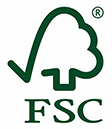Best Choices
Naturally Weather-Resistant Wood
Some types of wood, including cedar, black locust and Southern cypress, contain oils and tannins that make them naturally resistant to insects and decay. They do not require chemical treatment, but they still need to be waterproofed and stained. Some tropical hardwoods, like ipe and tigerwood, are also naturally resistant, but must be shipped overlong distances and are more expensive than cedar.
It is especially important to choose lumber certified by the FSC. And, if possible, choose FSC-certified wood from local sources to minimize the large carbon footprint that results from shipping wood long distances.
If FSC-certified wood is not available, your next best option is to use locally and sustainably harvested wood with a traceable source. Look for local companies that both harvest and sell the lumber, so you can more easily track the wood’s origin.
Recycled Plastic Planking
Plastic planking made from recycled material is another good option. Look for products made with high post-consumer recycled content that is mostly comprised of HDPE (high-density polyethylene) or LDPE (low-density polyethylene). These products are made from recycled plastics such as milk jugs and grocery bags. Avoid fiberglass-reinforced and PVC plastic materials, as they contain hazardous chemicals.
Plastic planking doesn’t need to be painted, stained or sealed. It’s stain-resistant and won’t crack or splinter. It’s also less toxic than pressure-treated wood preserved with chemicals. But, because it is not as strong as wood, plastic decks can sag under too much weight, and temperature changes can cause the material to expand and contract.
Reclaimed Wood
Using reclaimed or salvaged wood eliminates the need to harvest new trees. Look for wood like cedar or redwood, but take care to learn where your wood came from, as old wood from decks, porches or fence posts is likely to be chemically treated. Note that arsenic-treated wood has a green tint that weathers to gray.
Resources like the Building Materials Reuse Association’s database, CalRecycle in California, Community Forklift in Washington, D.C., or Big Reuse in New York can help you find sources of untreated, reclaimed wood.
Aluminum Decking
Aluminum decking is good choice because it is lighter, stronger and more durable than wood or plastic. It is also waterproof, completely weather and pest-resistant, and 100 percent recyclable, but it can be quite expensive.
